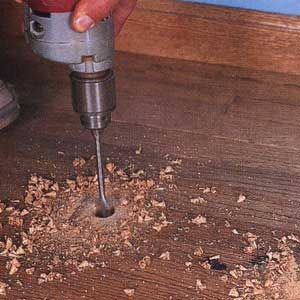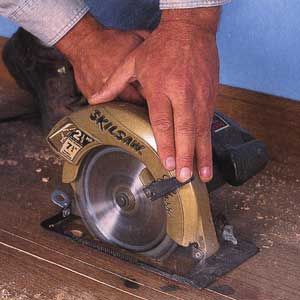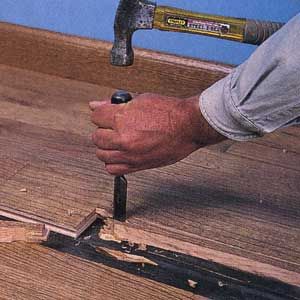Hardwood floors add a natural and warm design to many homes, but they’re also susceptible to damage from everyday wear and tear. When stains, scratches, and other imperfections start to show up on your wood floors, you need an effective solution to restore them. Our guide walks you through repairing damaged hardwoods, from figuring out the problem to applying the finishing touches.
Understanding Wood Floor Damage
Before getting started, you’ll want to understand the cause and extent of the damage to your floors. This will help you determine the best course of action for a successful and long-lasting repair.
Wood floors can be damaged by various sources. The most common causes include areas with high foot traffic, spills and stains, furniture scratches, pet claws, water damage, and sun exposure.
First, examine the affected area to determine the severity of the damage. Minor scratches or shallow stains can likely be remedied with simple refinishing techniques. However, deep gouges, discoloration, or warped boards may require more extensive repairs, such as board replacement.
Essential Tools and Materials for Wood Floor Repair
The first step for a successful wood floor repair project is gathering the right tools and materials. Having everything on hand before you start will help the process go smoothly.
Tools Needed for Patching
To patch damaged wood floors, you’ll need:
- Circular saw
- Drill with a spade bit
- Hammer
- Measuring tape
- Pry bar
- Safety goggles and dust mask
- Sharp chisel
Materials Required for Repair
Before starting the project, check that you have these materials ready and available:
- Finishing nails
- Replacement floorboards (matching wood species and dimensions)
- Sandpaper (various grits)
- Stain (matching existing floor color)
- Polyurethane finish
- Wood filler
- Wood glue
Preparing the Damaged Wood Floor
Proper preparation is key for a seamless, simple repair. This involves carefully removing the damaged section and preparing the subfloor for the new board.
Removing the Damaged Floorboard
To remove the damaged board:
- Use a spade bit to drill 1-inch diameter holes at each end of the damaged board.
- Set your circular saw depth to match the thickness of the floorboard.
- Make two parallel cuts between the drilled holes to remove the center section.
- Carefully chisel out the remaining edges, being mindful of surrounding boards.
Cleaning and Prepping the Subfloor
Once the damaged board is removed:
- Inspect the subfloor for any issues that may have contributed to the damage.
- Clean the area thoroughly, removing any debris or old adhesive.
- If necessary, level the subfloor to get a smooth surface for the new board.

How To Patch Wood Floor
With the damaged board removed and the area prepped, you’re ready to install the replacement board. Follow the steps below for a professional-looking repair.
Measuring and Cutting the Replacement Board
- Measure the length of the removed section precisely.
- Cut a new piece of flooring to fit snugly into the space, making square cuts at both ends.
- Test-fit the new piece to confirm a proper fit.
Installing the New Floorboard
- Turn the new board upside down and use a chisel to remove the lower lip of the grooved edge. This allows it to fit over the tongue of the adjacent board.
- Apply wood glue to the tongues and grooves of both the new and existing boards.
- Carefully slide the new board into place, checking that it fits tightly on all sides.
Securing the Replacement Board
- Protect the new board with a scrap wood block and tap it down gently with a hammer.
- Cover the board with wax paper and place heavy weights on top overnight for proper adhesion.

Finishing Techniques for Seamless Wood Floor Repair
The final steps in the repair process involve seamlessly blending the new board with the existing floor. This provides a clean finish that matches the new board with your already installed hardwoods.
Sanding the Patched Area
- Once the glue has dried, sand the entire repaired area, being careful not to remove too much finish from the surrounding boards.
- Start with coarse-grit sandpaper and progressively move to finer grits for a smooth finish.
Staining To Match Existing Floor
- Test stain colors on scrap pieces of wood to find the closest match to your existing floor.
- Apply the stain to the new board, following the manufacturer’s instructions.
- Allow the stain to dry completely before proceeding.
Applying Protective Finish
- Apply two coats of clear polyurethane varnish to protect the repaired area.
- Allow each coat to dry thoroughly, lightly sanding between applications for a clean finish.
Alternative Wood Floor Repair Methods
For minor damage or situations where board replacement isn’t feasible, consider alternative repair techniques. Wood filler and partial replacements are great options and sometimes easier tasks.
Using Wood Filler for Minor Damage
Wood filler can quickly repair small scratches, dents, or gaps. Follow the steps below to easily apply wood filler to smaller damaged areas.
- Clean the damaged area thoroughly.
- Apply wood filler with a putty knife, slightly overfilling the area.
- Once dry, sand the filler flush with the surrounding wood.
- Stain and finish the area to match the existing floor.
Partial Board Replacement Techniques
For damage that doesn’t affect the entire board:
- Cut out only the damaged section of the board using a circular saw and chisel.
- Cut a matching piece of flooring to fit the removed section.
- Secure the new piece with wood glue and finish by sanding and staining the area.

Preventing Future Wood Floor Damage
Taking proactive steps can help maintain your wood floors and prevent future damage. Regularly maintaining your hardwood floors and adding protective features to high-traffic areas can help your floors look sleek and remain durable for years.
Regular Maintenance Tips
- Clean spills immediately to prevent staining.
- Maintain consistent indoor humidity levels to prevent wood expansion and contraction.
- Sweep or vacuum regularly to remove dirt and debris.
- Use felt pads under furniture legs to prevent scratches.
Protective Measures for High-Traffic Areas
- Consider applying an extra layer of finish in high-traffic areas for added protection.
- Implement a no-shoes policy to reduce wear and tear around your home.
- Place rugs or mats in entryways and high-traffic zones.
Replacing Wood Floor Finishes for Longevity
Sometimes, protecting your floor goes beyond the usual repairs. Wood floors confront a lot of wear every day. Harsh cleaning chemicals, heavy traffic, and ultraviolet exposure can affect the finish. If your wood floors start looking dull or show signs of surface wear, it might be time to replace the finish, adding shine and a new protective layer.
First, decide what finish is most suitable for your home based on foot traffic and the completed look you want. Water-based polyurethane is durable, making it a popular choice for busier areas. For a more traditional look, you should consider an oil-based polyurethane, which tends to enhance the wood’s natural tones.
Step-by-Step Finish Replacement
- Clear the room for unobstructed access to your floors.
- Thoroughly clean the floor to remove all dirt and grime.
- Lightly sand the surface for proper adhesion of the new finish.
- Apply the finish evenly, following the manufacturer’s instructions.
- Allow for drying time before moving furniture back and walking on the floor.
Implementing Preventive Maintenance
Keeping your wood floors in good condition should extend beyond periodic repairs and finishes. Implementing preventive maintenance strategies can save you time and money in the long run, as the alternative may result in replacing your floors.
Scheduled Cleaning Routine
A regular cleaning schedule prevents the buildup of dirt and debris, minimizing scratches and surface damage. We suggest using a microfiber mop or a vacuum designed for hardwood floors. Always avoid wet mopping since too much moisture can damage the wood.
Seasonal Care for Wood Floors
Seasonal changes can significantly impact wood floors. In the winter, dry air from heating systems can cause the wood to shrink, while summer humidity can lead to expansion. To maintain normal humidity levels and protect your floors, we recommend using a humidifier during the winter months and a dehumidifier in the summer.
Doormats and Area Rugs
Placing doormats at entry points helps capture dirt before it reaches your floors. In high-traffic zones, area rugs offer additional protection and can be a nice addition to your room. Regularly shake out and clean these mats so they can reliably trap dirt.
When To Call a Floor Restoration Professional
While many wood floor repairs can be DIY projects, some situations call for professional expertise. When dealing with water damage, structural issues affecting the subfloor, larger areas needing repair, or detailed flooring patterns, it’s best to hire a professional.
While higher in cost, professional floor restoration services can easily match wood and finishes to your existing floor. They also have access to specialized tools and materials that produce a better finish. For larger projects, professionals will likely be more efficient than the average DIYer, and some restoration companies offer warranties for your new floors.
Patching Wood Floors: Our Conclusion
Patching damaged wood floors is a rewarding DIY project that can restore your floors. With the right tools, materials, and techniques, you can achieve professional-looking results. Remember to prepare thoroughly and take your time with each step of the repair process.
For minor damages, wood filler or partial board replacement may suffice. However, don’t hesitate to call in a professional for complex repairs or if you’re unsure about tackling the project yourself. Regular maintenance and preventive measures will help keep your wood floors looking their best for years.
